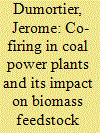| Srl | Item |
| 1 |
ID:
124333


|
|
|
|
|
| Summary/Abstract |
Several states have a renewable portfolio standard (RPS) and allow for biomass co-firing to meet the RPS requirements. In addition, a federal renewable fuel standard (RFS) mandates an increase in cellulosic ethanol production over the next decade. This paper quantifies the effects on local biomass supply and demand of different co-firing policies imposed on 398 existing coal-fired power plants. Our model indicates which counties are most likely to be able to sustain cellulosic ethanol plants in addition to co-firing electric utilities. The simulation incorporates the county-level biomass market of corn stover, wheat straw, switchgrass, and forest residues as well as endogenous crop prices. Our scenarios indicate that there is sufficient feedstock availability in Southern Minnesota, Iowa, and Central Illinois. Significant supply shortages are observed in Eastern Ohio, Western Pennsylvania, and the tri-state area of Illinois, Indiana, and Kentucky which are characterized by a high density of coal-fired power plants with high energy output.
|
|
|
|
|
|
|
|
|
|
|
|
|
|
|
|
| 2 |
ID:
185724


|
|
|
|
|
| Summary/Abstract |
In this paper, we examine the direct consequences of waste by-product reuse in a polluting industry, namely, India's coal-fired electric power sector, where ‘fly ash’ is legally required to be used as a substitute input in other industries. We first develop a simple theoretical model to gain insight and derive testable hypotheses applicable to our specific empirical setting. We provide empirical support for our model's predictions by exploiting plant-level variation in fly ash utilization. Results indicate greater reuse of fly ash per kWh of generation increases coal consumption per kWh, reduces the quality of coal used, and increases plant-level CO2 emissions per kWh. These results suggest the potential benefits of this policy—e.g., reduced waste disposal costs—may be offset by unanticipated increases in other external costs, particularly if not accompanied by supplementary regulation of other forms of pollution.
|
|
|
|
|
|
|
|
|
|
|
|
|
|
|
|